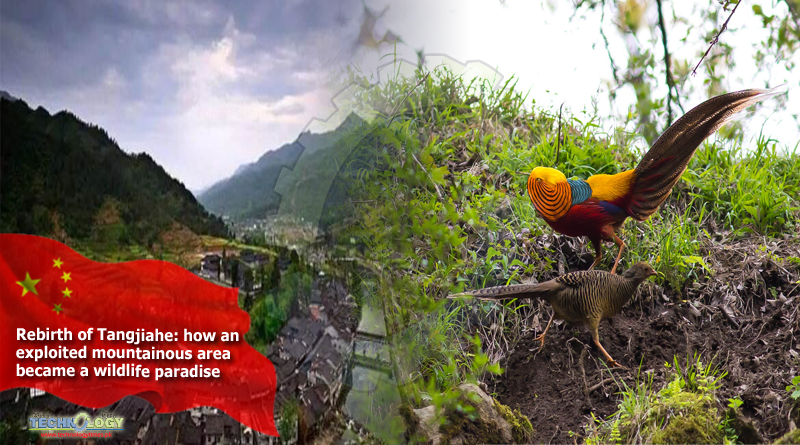Early in the morning, as the sun shines through the leaves in the Tangjiahe National Nature Reserve in southwest China’s Sichuan Province, birds usher in a fine summer day by twittering in the mountain forests.

The reserve, about 40,000 hectares in area, gets its name from the small Tangjia River, which snakes through the reserve and flows into a tributary of the Yangtze, China’s longest river.
The reserve currently has more than 3,700 types of animals and plants, and 96 percent of the reserve is covered by forests.
However, the area where the reserve is located used to be a desolate wasteland. The story of Tangjiahe’s transformation has come to the spotlight as China observes the International Day for Biological Diversity on Friday.
Historically, people living in the vicinity depended on the mountains to make a living. Locals exploited the land, hunted animals and logged trees in the forests.
In 1965, a logging factory was established there. This meant that more than 1,000 workers would cut down almost 30,000 cubic meters of wood every year to support the country’s construction work.
As the logging work went into overdrive and frequent poaching scared away animals, the ecosystem at Tangjiahe broke down and the mountainous area exuded a sense of desolation.
“Animals just ran way,” said Pu Youhai, an elderly animal hunter. “At that time, you had to go to places very high, very far to find animals.
In 1975, local officials decided that the situation needed to be addressed and they applied to make the area into a nature reserve to better preserve its rare animals and plants. Construction of the reserve was completed after three years, upon which the logging factory ceased operation.
In 1983, the reserve built an observation station for giant pandas, making it the second of its kind at that time. Many seasoned experts came to the Tangjiahe reserve to track, monitor and research giant pandas, which provided valuable research material for the protection of the chubby bears and their habitat.
Meanwhile, human activities began to be strictly confined in the 1980s at the reserve. In 1985, the Sichuan provincial government allocated more than 1.2 million yuan (about 168,600 U.S. dollars) to help relocate hundreds of villagers from the heartland of the reserve to the outside, giving way to rare plants and animals such as the pandas.
As Tangjiahe is located where wild giant pandas live in groups, China has included the reserve in its pilot national giant panda park that broke ground in 2016. According to a national survey, the reserve is home to 39 wild giant pandas.
Ma Wenhu, 51, has been patrolling the nature reserve for more than 20 years.
“Wild animals have always lived here at Tangjiahe, and it is my job to protect the area so that the animals can thrive rather than going into extinction,” he said.
These days, many animals under state protection have returned to Tangjiahe, including Chinese monal pheasants, golden pheasants and blood pheasants, Ma said.
“I can distinguish the sounds of more than 100 different types of birds,” he said.
Ma always takes a camera with him while patrolling. In 2014, he captured the image of a wild otter, which is under Class Two state protection in China. It was the first time that a wild otter was caught on camera in the country since 2000.
Other rare animals have also appeared at Tangjiahe. For example, the grey-crowned crowtit was only spotted in Tangjiahe and Jiuzhaigou, both in Sichuan Province, since the late 19th century.
In 2014, Tangjiahe made it on the International Union for Conservation of Nature Green List of Protected and Conserved Areas. The nature reserve furthered the protection efforts by compiling a textbook about the natural environment, in addition to building seven museums of natural science. Last year, about 5,000 students from middle schools and primary schools visited Tangjiahe.
Meanwhile, locals are living in harmony with the mountains these days by adopting a model of green development. Local authorities pooled funds to help build rural cooperatives in industries such as beekeeping and fruit cultivation.
“I have raised scores of hives of bees,” said villager Yang Tingxiu, 54. “We can make up to 70,000 yuan more every year thanks to the bees.” Yang also runs a family inn. The family can make more than 100,000 yuan of revenue annually.
In Yinping Village, a few km from the reserve, more than 100 family inns have sprung up, offering delicacies and lodging for tourists.
“Almost every family has stepped into the family-inn business,” said village official Luo Chengpeng.
Deng Xiaofeng, 42, opened the first family inn in the village 14 years ago. After expansion, her business now has 32 guest rooms. Last year, she raked in more than 200,000 yuan in tourism revenue.
“The environment is getting better, and our lives are getting better,” she said. Enditem
This news was originally posted on xinhuanet.com
